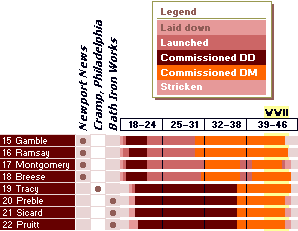Among the lessons World War I offered the US Navy was the possibility that fast ships could be effective in laying minefields to disrupt enemy operations. The surplus of flush-deckers at the end of the war provided an opportunity to experiment.
EX-WICKES AND CLEMSON CLASS
USS
Stribling (DM 1, ex-DD 96).
USS
Murray (DM 2, ex-DD 97).
USS
Israel (DM 3, ex-DD 98).
USS
Luce (DM 4, ex-DD 99).
USS
Maury (DM 5, ex-DD 100).
USS
Lansdale (DM 6, ex-DD 101).
USS
Mahan (DM 7, ex-DD 102).
USS
Hart (DM 8, ex-DD 110).
USS
Ingraham (DM 9, ex-DD 111).
USS
Ludlow (DM 10, ex-DD 112).
USS
Burns (DM 11, ex-DD 171).
USS
Anthony (DM 12, ex-DD 172).
USS
Sproston (DM 13, ex-DD 173).
USS
Rizal (DM 14, ex-DD 174).
USS
Gamble (DM 15, ex-DD 123).
USS
Ramsay (DM 16, ex-DD 124, later AG-98).
USS
Montgomery (DM 17, ex-DD 121).
USS
Breese (DM 18, ex-DD 122).
USS
Tracy (DM 19, ex-DD 214).
USS
Preble (DM 20, ex-DD 345, later AG-99).
USS
Sicard (DM-21, ex-DD 346, later AG-100).
USS
Pruitt (DM 22, ex-DD 347, later AG-101).
On 17 July 1920, fourteen ships—Stribling, Murray, Israel, Luce, Maury, Lansdale and Mahan (ex-DDs 96–102); Hart, Ingraham and Ludlow (ex DDs 110–12); and Burns, Anthony, Sproston and Rizal (ex-DDs 171–174)—were reclassified DMs 1–14. Their torpedo tubes were replaced with tracks that could carry approximately 80 mines. Work was completed during the following year.
Six of these ships lasted only until 1930, when they were scrapped. In their place, four flush-deckers were were converted and recommissioned: Gamble (DM 15) and Ramsay (DM 16) in 1930; Montgomery (DM 17) and Breese (DM 18) in 1931. Similarly, in 1936–37, the remaining eight original DMs were scrapped and replaced by four more converted flush-deckers, Tracy, Preble, Sicard and Pruitt (DMs 19–22). Montgomery and Breese were decommissioned in 1937 but recommissioned in 1939.
OPERATIONS
All eight active destroyer-minelayers were present at Pearl Harbor when the Japanese attacked, 7 December 1941. Their ensuing World War II careers in the Pacific were eventful, with mining operations commencing in 1942 in the Solomon and Aleutian Islands. First blood was drawn east of Guadalcanal in the Solomons on 29 August, not by mining but by depth charging, when
Gamble became the first destroyer type to sink a full-sized Japanese submarine,
I-123.
There were two mining successes in the Solomons.
- On 1 February 1943, destroyer Makigumo was sunk in a minefield laid off Guadalacanal by Tracy, Montgomery and Preble.
- On 7 May, Radford led Gamble, Preble and Breese in an offensive operation to the New Georgia Group. Approaching Kolombangara from the south through Ferguson Passage, the three laid 250 mines in 17 minutes across narrow Blackett Strait, well-known route of the Tokyo Express to Vila. The following night, three unsuspecting destroyers of veteran Japanese Destroyer Division 15—which had conducted more Tokyo Express operations to Guadalcanal than any other division—ran into it from the east at 18 knots enroute home from their advance base at nearby Vila plantation. Kuroshio sank immediately; class leader Kagero and division flagship Oyashio were disabled. Despite rescue barges sent out from Vila, they remained exposed to attacks by American aircraft, which found and bombed them the following day. Both eventually sank.
Mine Squadron 1
1941
USS Oglala (CM 4), flag
Mine Division 13
USS Tracy (DM 19), flag
USS Preble (DM 20)
USS Sicard (DM 21)
USS Pruitt (DM 22)
Destroyer Division 14
USS Gamble (DM 15), flag
USS
Ramsay (DM 16)
USS
Montgomery (DM 17)
USS
Breese (DM 18)
Radford and her charges repeated their operation the following week in Kula Gulf, but this time the Japanese swept up their minefield immediately.
Meanwhile, Sicard, Pruitt and Ramsay, joined briefly by Montgomery in September–November 1942, were deployed to the Aleutians where, 10 May 1943, Sicard T-boned Macdonough, then towed her into Adak.
LOSSES
Two flush-deck destroyer-minelayers did not survive to the end of the war.
- On 25 August 1943, Montgomery collided with Preble; both were repaired. On 17 October 1944, while anchored in a lagoon off Palau, she fouled a drifting mine before she could get under way. Towed to Ulithi, she was repaired sufficiently to steam home to San Francisco, where she decommissioned.
- Gamble was damaged 18 February 1945 in an air attack off Iwo Jima while screening battleship Nevada. Towed to the Marianas, she was scuttled off Guam.

Converted flush-deck destroyer-minelayers in World War II.
The remaining ships served out the war; all but Tracy and Breese were reclassified as auxiliaries. After the surrender, Tracy swept mines in Japanese home waters and became the first Allied ship to enter Nagasaki Harbor.
Thereafter, like all surviving flush-deckers, the minelayers outlived their usefulness and were sold for scrapping before the end of 1946.
SERVICE STARS AND AWARDS
Collectively, the flush-deck minelayers earned 44 service stars in World War II, led by the ships that spent the most time in the Solomons.
Montgomery also was awarded the Navy Unit Commendation for her action at Palau 12–15 September 1944.
SUCCESSORS
In September 1943. following the success at Blackett Strait, CNO Admiral Ernest J. King authorized BuShips to fabricate kits for converting four
Fletcher-class destroyers as minelayers. These were not used, but on 24 June 1944, Admiral Nimitz recommended conversion of twelve
Allen M. Sumner-class destroyers already laid down. Commissioned that August–October, the resulting
Robert H. Smith class ships also distinguished themselves in action—off Okinawa.

